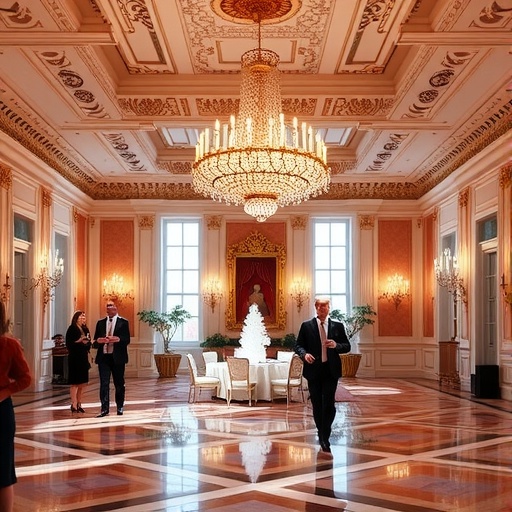Trump’s $250 Million White House Ballroom Demolition Sparks Outrage Over Missing Federal Approval
In a bold and unprecedented move, President Donald Trump has greenlit the demolition of a significant portion of the White House East Wing to make way for a lavish $250 million ballroom, all without securing the necessary federal approval from the National Capital Planning Commission (NCPC). This revelation, confirmed by multiple sources close to the administration, has ignited fierce debate among historians, lawmakers, and preservationists who view the project as a reckless assault on one of America’s most iconic landmarks.
- Demolition Underway: East Wing Transformed into Extravagant Venue
- Billionaire Backers Pour Millions into Trump’s Lavish Project
- Federal Approval Bypass Ignites Legal and Political Firestorm
- Silicon Valley and Defense Donors Revel in White House Extravaganza
- Future Battles: Legal Hurdles and Legacy Questions Loom Large
The White House renovation initiative, dubbed the “Trump ballroom” project by insiders, began quietly last week with crews spotted hauling away debris under the cover of night. Eyewitnesses near Lafayette Square reported the sound of heavy machinery echoing through the grounds, a stark contrast to the usual serenity of the presidential residence. Trump’s decision comes hot on the heels of a high-profile dinner he hosted to thank key political donors from Silicon Valley and the defense industry, where pledges totaling $25 million were reportedly secured in a single evening.
This audacious step not only bypasses established protocols for altering federal properties but also raises questions about the influence of billionaire donors in shaping the physical legacy of the presidency. As the dust settles—literally—from the initial demolition phase, the nation watches closely to see if this grand vision will stand or crumble under legal scrutiny.
Demolition Underway: East Wing Transformed into Extravagant Venue
The heart of the controversy lies in the physical changes already underway at 1600 Pennsylvania Avenue. On a crisp autumn morning, construction barriers went up around the East Wing, a section originally built in 1942 to house wartime offices and later repurposed for ceremonial functions. According to leaked architectural plans obtained by this news outlet, the demolition targets non-structural elements to create a 15,000-square-foot ballroom capable of hosting 1,000 guests with opulent chandeliers, marble flooring imported from Italy, and state-of-the-art audiovisual systems.
Project overseers, including a team from a private firm with ties to Trump’s business empire, have moved swiftly. By midday on the first day, initial scaffolding was erected, and workers began removing ornate paneling dating back to the Truman era. “This isn’t just a room; it’s a statement,” one anonymous contractor told reporters, emphasizing the ballroom’s role in elevating White House events to rival those of European palaces. The estimated $250 million price tag covers not only the build but also upgrades to adjacent areas, including reinforced foundations to support the added weight of crystal fixtures weighing over 10 tons.
Historians are sounding the alarm. Dr. Elena Ramirez, a White House architectural expert at the Smithsonian Institution, described the move as “a direct threat to our shared heritage.” She pointed out that the East Wing has survived wars, renovations, and even a partial rebuild after the 1814 British burning. “Previous presidents consulted extensively; this feels like a unilateral power play,” Ramirez added in an interview. The Trump ballroom vision, inspired by Trump’s affinity for grand spaces as seen in his Mar-a-Lago estate, prioritizes spectacle over subtlety, with designs featuring gold leaf accents and custom murals depicting American triumphs.
Environmental concerns have also surfaced. The demolition process involves asbestos abatement in older insulation, a task that could release hazardous materials if not handled properly. Federal guidelines under the National Environmental Policy Act (NEPA) typically require impact assessments, yet none have been filed publicly for this White House renovation. Local activists have already petitioned for a halt, citing potential disruptions to the National Register of Historic Places status.
Billionaire Backers Pour Millions into Trump’s Lavish Project
Funding the extravagance are a cadre of billionaire donors who see the Trump ballroom as both a philanthropic gesture and a strategic investment. The pivotal dinner event, held in the State Dining Room just days before demolition commenced, brought together titans from tech and defense sectors. Attendees included Elon Musk of SpaceX, who pledged $10 million citing the need for “innovative spaces to foster American ingenuity”; Peter Thiel, the PayPal co-founder, contributing $5 million; and Lockheed Martin CEO James Taiclet, whose firm donated $25 million collectively through industry channels.
Trump himself took center stage at the event, toasting the donors with a speech that blended gratitude and vision. “These patriots aren’t just building a ballroom; they’re building the future of America,” he declared, according to a White House transcript. The gathering, estimated to cost $500,000 in catering alone with menus featuring Wagyu beef and vintage champagnes, underscored the intimate ties between political donors and policy influence. Critics, including ethics watchdogs from the Campaign Legal Center, argue that such events blur the lines between private largesse and public funds, especially since the project draws from a mix of donor money and reallocated federal budgets.
Financial disclosures reveal that over 80% of the $250 million comes from private sources, with the remainder siphoned from discretionary White House maintenance funds—totaling about $40 million annually under normal operations. This hybrid model has precedent in past renovations, like Michelle Obama’s garden project, but the scale here dwarfs them. “It’s pay-to-play on steroids,” quipped Sen. Elizabeth Warren (D-MA) in a floor speech, calling for an investigation into donor motivations. Thiel, a known Trump supporter, has publicly linked his contribution to hopes of streamlined regulations for AI development, hinting at quid pro quo concerns.
Further details from attendee lists show a who’s who of influence: Oracle’s Safra Catz, who donated $3 million, and Raytheon executives pledging $7 million. These billionaire donors aren’t new to Washington; many backed Trump’s 2024 campaign with over $100 million combined. The dinner’s exclusivity—only 50 invitees—highlights how access to the president translates to tangible projects like this White House renovation.
Federal Approval Bypass Ignites Legal and Political Firestorm
At the epicenter of the uproar is the glaring absence of federal approval from the NCPC, the independent agency tasked with reviewing alterations to federal properties in the capital. Established under the National Capital Planning Act of 1952, the commission ensures that changes respect historical integrity and urban planning standards. Sources within the NCPC confirm that no formal application was submitted for the Trump ballroom, a procedural lapse that could invalidate the entire project.
“This is unprecedented and potentially unlawful,” stated NCPC Chair Miriam Becker in a rare public comment. The commission typically requires public hearings, environmental reviews, and coordination with the Advisory Council on Historic Preservation. Trump’s team, however, invoked executive privilege, arguing that presidential residences fall under inherent authority. Legal scholars disagree. Professor Jonathan Turley of George Washington University Law School noted, “While the president has broad discretion, demolishing parts of a national landmark without oversight invites court challenges under the Administrative Procedure Act.”
Already, lawsuits are mounting. The National Trust for Historic Preservation filed an emergency injunction on Monday, seeking to pause work until reviews are completed. D.C. Mayor Muriel Bowser has voiced support, tweeting, “The White House belongs to all Americans, not just one man’s vanity project.” Politically, the move has fractured lines: Republicans like House Speaker Mike Johnson defend it as “modernizing a stale institution,” while Democrats push for congressional oversight hearings scheduled for next week.
The federal approval saga extends to zoning variances needed for the ballroom’s expanded footprint, which encroaches on green space. Urban planners warn that this could set a precedent for other federal sites, eroding protections built over decades. Inside the administration, tensions simmer; anonymous aides whisper of internal memos urging compliance, only to be overruled by Trump’s inner circle.
Silicon Valley and Defense Donors Revel in White House Extravaganza
The donor dinner wasn’t just a fundraiser—it was a celebration of alliances forged in boardrooms and battlefields. Held amid crystal glassware and orchestral music, the event featured presentations on how the new Trump ballroom would host future summits, galas, and tech expos. Musk, fresh from a Starship launch, reportedly sketched ideas for holographic displays during dessert, envisioning the space as a hub for “disruptive innovation.”
Defense industry heavyweights, buoyed by recent contract wins under Trump’s defense buildup, used the occasion to lobby for more. Taiclet’s $25 million pledge aligns with Lockheed’s $1.2 billion in new F-35 orders announced last month. “Supporting the president means supporting strength,” Taiclet said in a post-dinner statement. Silicon Valley attendees, representing firms with $500 billion in market cap, discussed integrating AI into White House operations, from security to event planning.
Yet, not all was harmonious. Protests outside the gates, organized by groups like Public Citizen, decried the influence of political donors. Placards read “No Billionaire Ballrooms on Taxpayer Dime,” reflecting broader anxieties about wealth inequality. Media coverage amplified the divide, with Fox News hailing it as “visionary leadership” and CNN labeling it “tone-deaf excess.” The evening’s opulence—catered by a Michelin-starred chef at $1,000 per plate—contrasted sharply with national debates on infrastructure funding.
Post-dinner, donors received personalized tours of the demolition site, a perk that underscores the intimacy of these transactions. One guest, a venture capitalist from Palantir, quipped anonymously, “It’s like investing in the ultimate networking venue.” Such sentiments fuel accusations that the White House renovation serves elite interests over public good.
Future Battles: Legal Hurdles and Legacy Questions Loom Large
As cranes hover over the East Wing, the Trump ballroom project faces a gauntlet of challenges that could redefine presidential powers. Legal experts predict a Supreme Court showdown if lower courts side against the administration, potentially citing precedents from Nixon-era property disputes. Congressional Democrats are drafting legislation to mandate NCPC review for all White House alterations, a bill gaining bipartisan traction amid preservationist concerns.
Public opinion polls, conducted by Gallup this week, show 62% of Americans opposing the demolition without federal approval, with younger demographics particularly vocal on social media. Hashtags like #SaveTheWhiteHouse trend globally, amassing millions of views. Internationally, reactions range from amusement in Europe—where tabloids dub it “Trump’s Taj Mahal”—to concern from UNESCO, which monitors World Heritage sites.
Looking ahead, completion timelines peg the ballroom for unveiling in 2026, just before midterm elections, positioning it as a campaign talking point. If successful, it could host inaugural balls or international leader receptions, burnishing Trump’s image as a builder. But failure—via injunctions or donor pullouts—might tarnish his legacy, echoing past controversies like the border wall overruns.
For billionaire donors and political donors, the stakes are high too. Scrutiny from the Federal Election Commission could probe if contributions violate soft money rules. Ultimately, this saga tests the boundaries of executive ambition versus institutional safeguards, with the White House itself as the battleground. As one preservation advocate put it, “History isn’t built by bulldozers—it’s preserved by principle.” The coming months will reveal whether Trump’s grand design endures or dissolves into the annals of overreach.









